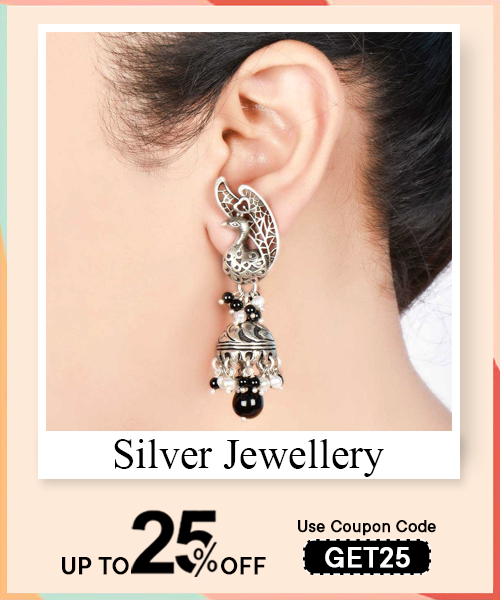Silver is a metal that has captivated people for centuries, both for its stunning beauty and its numerous practical uses. From ancient civilisations to modern-day jewellery designers, silver has remained a timeless symbol of elegance, value, and craftsmanship. Its natural shine and malleability make it ideal for creating intricate designs, whether in jewellery, art, or functional items.
Silver’s allure extends beyond its aesthetic appeal. Known for its durability, antimicrobial properties, and unique cosmic origins, silver continues to be a beloved material for both decorative and health-related purposes.
In this article, we will explore some fascinating qualities and facts about silver that make it a cherished and versatile metal.
The timeless beauty of silver in craftsmanship is prevalent throughout the centuries, especially in stained glass windows seen in historical monuments such as the Jodhpur Fort or Udaipur Palaces.
Silver pigments and stains are often added to stained glass to enhance its brilliance and durability, creating breathtaking works of art that stand the test of time.
Silver-coated lab coats for doctors define metal’s health benefits beyond jewellery, too. Doctors, surgeons, and healthcare specialists often prefer silver-coated lab coats because of silver’s natural ability to resist bacteria and prevent infections.
Silver’s antimicrobial properties help reduce the spread of harmful microorganisms, making it an ideal choice for healthcare professionals who prioritise both their own health and the well-being of their patients.
Being the mystical, the cosmic origin of silver makes it a stardust in our jewellery. Silver’s allure isn’t just earthly—it’s cosmic. Silver, along with other precious metals, is formed in the hearts of exploding stars in supernovae. The stardust from these celestial events eventually settles on Earth, bringing the beauty and brilliance of the universe into our lives through jewellery.
This cosmic origin is part of what makes silver so unique, reflective, and special in the world of fine jewellery.
The effects of excessive silver consumption need to be rationalised and understood; let us understand Argyria. While silver is known for its beneficial qualities, it’s important to use it in moderation. Homoeopathic treatments may recommend drinking silver solutions for health benefits, but excessive consumption can lead to a condition called Argyria, which causes the skin to take on a bluish tint. It’s always essential to approach silver-based treatments with caution to avoid any adverse effects.
Read More:Birthday Decoration Ideas: 12 Wonderful Wall Decoration Ideas For Birthday
Let us dive into the fascinating history of silver, which, being one of the earliest metals discovered by human civilisation, carries a remarkable legacy. Among the first five metals unearthed by ancient societies, alongside gold, copper, lead, and iron, silver’s discovery by the Sumerians marks the dawn of metallurgy.
The ancient world was drawn to silver not only for its rarity but also for its lustrous beauty, making it a symbol of wealth, power, and prestige. Over the centuries, silver evolved from a prized medium of exchange to a versatile tool used in everything from coinage to decorative art. Its enduring appeal remains evident today, woven into the very fabric of human history.
Silver Thursday, or the rise and fall of the Hunt brothers, stands as a cautionary tale in financial history, capturing the complex dynamics of ambition and market speculation.
The Hunt brothers, ambitious oil magnates, sought to corner the silver market in the 1970s, acquiring vast quantities of the precious metal. Their actions caused silver prices to soar, creating a financial frenzy.
However, the market’s volatility led to a sharp crash, and the Hunt brothers’ fortunes dissipated. Their story reminds us of the inherent risks of speculation and the unpredictable nature of commodities, making it a landmark event in economic history.
The ductility of silver needs to be analysed, as it is truly a marvel in terms of its physical properties. This allows silver to be drawn into an incredibly fine wire or sheet. A single grain of silver can be extended into a wire over a thousand meters long or pressed into a sheet thinner than paper.
Such malleability has made silver an indispensable resource in a variety of industries, including electronics, jewellery making, and even solar energy production. Its unique combination of flexibility, strength, and lustre makes it one of the most versatile metals known to humanity.
Silver filters for safe drinking water for astronauts is due to metal’s antibacterial properties extending beyond earthly uses to the vacuum of space, where it plays a crucial role in water filtration systems aboard spacecraft.
Silver-infused water filters help ensure that astronauts can access clean, purified drinking water while in space. The metal’s natural ability to prevent microbial growth makes it ideal for preserving water’s safety and purity over long periods. This application not only underscores silver’s practical utility but also highlights its role in safeguarding health in extreme environments.

The werewolf virus and the silver bullet are closely linked, and it is one of the most crucial events in the history of metal. In ancient folklore, silver was often associated with mystical powers, particularly in relation to the famous "silver bullet" believed to kill werewolves.
This belief had roots in the idea that silver could neutralise harmful substances, and it was often portrayed as the antidote to dangerous forces. In reality, this myth stems from the fact that silver’s antibacterial properties can eliminate certain harmful pathogens, such as hydrogen sulphide, a compound linked to disease. The silver bullet, while rooted in fiction, finds a fascinating connection to science through its medicinal and purifying qualities.
Silver-plated instruments for magical performance are often a choice of musicians for their unique tonal qualities and durability. Silver’s resistance to tarnishing and corrosion makes it an ideal material for instruments such as trumpets, flutes, and saxophones.
Not only does silver enhance the aesthetic appeal of musical instruments, but it also helps maintain the purity of sound, contributing to better acoustics and performance. For professional musicians, silver-plated instruments offer an unmatched combination of beauty, functionality, and longevity, making them an indispensable part of their musical journey.
Uses of silver in medicine, wound healing, and cosmetics, throughout history, have been hailed for its healing properties. In ancient times, the metal was used in medicinal applications, particularly for wound healing, due to its natural antibacterial qualities.
Silver-based treatments were even used during world wars to prevent infection in soldiers' wounds. The great physician Hippocrates praised silver for its healing potential, and it was often incorporated into remedies for a variety of ailments.
Today, silver continues to be used in medical products, including wound dressings and cosmetic products, to promote healing and prevent infection, demonstrating its lasting impact in the field of medicine.
Read More:10 Water Fountain Hacks for Decorating Purpose
The symbolic significance of silver across cultures is profound, as metal has long been revered as a symbol of purity, wealth, and spiritual significance in various cultures around the world.
In Native American traditions, silver is seen as a protective force, often paired with turquoise in jewellery to enhance its spiritual power.
In India, silver is considered a symbol of prosperity and is commonly worn during religious celebrations and festivals to invite good fortune.
The Middle East also regards silver as a symbol of wealth and blessings, with ornate silver jewellery being a common gift.
The history of silver craftsmanship in the town of Taxco, Mexico, is renowned for its intricate designs and artistic excellence. Silver jewellery in Africa is deeply rooted in cultural traditions, often representing status and wealth.
In Western countries, silver is frequently passed down through generations as a cherished heirloom, signifying familial bonds and legacy. Silver transcends geographic and cultural boundaries, uniting people through its beauty, significance, and enduring legacy.
Silver’s antibacterial properties stem from its ability to release silver ions (Ag+), which are highly reactive. These ions disrupt essential cellular functions in bacteria by binding to proteins, DNA, and cell membranes. The process inhibits the bacteria's ability to reproduce and damages its structure, effectively killing it.
Additionally, silver ions generate reactive oxygen species (ROS), which cause oxidative stress, further impairing bacterial cells. Unlike many chemical antibacterial agents, silver works across a broad spectrum of bacterial species, including antibiotic-resistant strains, making it an invaluable resource in healthcare, water purification, and antimicrobial coatings.
Silver is born in the fiery crucibles of massive stars during their final stages of life. When a star exhausts its nuclear fuel, it undergoes a supernova explosion, scattering its elements into the universe. During this event, extreme temperatures and pressures trigger rapid neutron capture processes (r-process), where atomic nuclei absorb neutrons, creating heavier elements like silver.
This stellar debris eventually coalesces into new stars, planets, and other celestial bodies. Earth’s silver reserves were deposited billions of years ago during the planet's formation, giving every silver artifact a cosmic heritage rooted in the life cycles of stars.
Silver’s unparalleled electrical and thermal conductivity make it the metal of choice in electronics. It offers minimal resistance to electrical flow, ensuring efficient energy transfer, which is crucial in devices like smartphones, computers, and solar panels.
Additionally, silver’s ability to withstand high temperatures and corrosion enhances its durability in electronic components. It’s used in switches, connectors, and circuit boards to improve performance and reliability. Its reflectivity also makes it ideal for solar panels, where it maximizes light absorption. Despite its cost relative to other metals, its superior efficiency and longevity make silver indispensable in advanced technology.
Mix a few drops of mild dish soap with warm water. Use a soft cloth to gently rub the silver, rinse thoroughly, and dry with a microfiber cloth.
Line a bowl with aluminum foil, add hot water, and mix in a tablespoon of baking soda. Place the silver item in the solution, allowing the chemical reaction to remove tarnish. Rinse and dry carefully.
These pre-treated cloths are specifically designed to clean silver without scratching.
Use commercial silver cleaners sparingly and follow the instructions to avoid over-polishing or damaging the item.
Avoid abrasive materials, ammonia, or bleach, as these can erode silver's surface or leave scratches.
Pure silver items are often stamped with marks like "925" (indicating 92.5% silver in sterling silver) or "999" (99.9% fine silver). Check for these identifiers in inconspicuous places.
Pure silver is non-magnetic. If the item is attracted to a magnet, it may contain other metals.
A small drop of nitric acid on a silver surface will reveal its authenticity. Pure silver turns creamy white, while fake silver may show green or other colors.
Gently tap the silver item. Pure silver produces a high-pitched, clear tone, whereas impure metals have a duller sound.
Silver tarnishes over time, forming a black layer of silver sulfide. Items that don't tarnish might not be pure silver.
Jewelers and assay offices can perform accurate tests using X-ray fluorescence or other advanced methods to confirm purity.
Read More:Top 15 Birthday Decoration Ideas At Home With Balloons
Silver is not only valuable for its aesthetic appeal and historical significance, but it also holds unique physical qualities that set it apart from other metals. It is the best conductor of electricity among all metals, making it crucial for modern electronics and technology. Silver is also highly reflective, which is why it is used in mirrors and solar panels, maximizing the efficiency of solar energy. Additionally, silver’s hypoallergenic properties make it an ideal choice for jewellery, ensuring that it is safe for people with sensitive skin. These lesser-known qualities further illustrate why silver remains indispensable in so many areas of life.

















